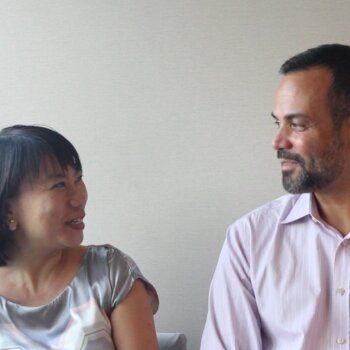Mindfulness is non-judgemental present moment awareness. That means you’re not thinking about the past, you’re not thinking about the future, you’re 100% here-and-now. And rather than judging your experience as either good or bad you’re simply accepting it with curiosity.
WHAT DOES MINDFULNESS DO FOR OUR BRAINS?
Evolution has designed us to be miserable. Our ancestors survived to breed because they saw every potential threat as real; by running away from every rustle in the bushes they avoided being killed. Their brains evolved to cling to bad memories, anticipate worse in the future, and fear change and strangers. As a result our amygdalas, almond-sized parts of the brain, react more to negative than positive events, causing a “negativity bias“. Although many of us now live comparatively safe lives our brains still respond to everyday situations as though they mean life or death, noticing negative stimuli around five times more than positive and often interpreting neutral events as negative.
The good news is through mindfulness we can rewire our brains, including reducing the amygdala’s overreactions. While once it was believed our brains were hard-wired by the time we reached adulthood, science has shown we continue to generate new brain cells throughout our lives. We can also modify the pathways signals follow within our brains and hence change our habitual ways of thinking.
There’s a saying “cells that fire together wire together“. Simplistically put, when particular messages often travel through our brains those connections become stronger, like pathways worn into a grassy meadow, meaning we’re more likely to think that way in the future. This is how a repeated action like driving eventually becomes automatic. It also means we can either accidentally or deliberately embed patterns of thoughts and hence emotions and behaviour. Given evolution has programmed us to feel disproportionate fear and focus on negative memories we’re naturally set up to feel anxious about the future and sad or angry about the past. However on the upside we can consciously choose to use our brains differently, in particular by practicing mindfulness, creating more constructive habitual thought patterns and emotions.
Meditation, one of the most common ways to practice mindfulness, has been demonstrated to increase activation of the anterior cingulate cortex (ACC). Activation of the ACC has a number of positive effects, including improving self-regulation and learning from past experience. In addition MRI scans of novices who undertook mindfulness meditation practices for 30 minutes a day over eight weeks showed “increased cortical density and thickness of the grey matter in the prefrontal cortex, the areas associated with empathy and compassion; and in the hippocampus, the brain area associated with learning and memory“. The increase in density is visible evidence these areas have become more active and effective.
Anterior Cingulate Cortex (ACC)
WHAT ARE SOME OF THE BUSINESS BENEFITS OF MINDFULNESS?
Better decision-making and strategic flexibility
Our evolution-imposed fear response encourages us to inappropriate knee-jerk responses. It narrows our perspective so we misinterpret situations and often miss the bigger picture. Meditation has been shown to promote improved problem-solving, with people more often choosing correct answers, learning from past experience, able to switch strategies when appropriate, and making less biased decisions.
Increased productivity through improved focus, memory and concentration
How much more effective could you be if you were able to maintain focus and concentration for longer periods of time? Heightened activity of the ACC helps you to resist distraction and keep you on-task, and undergoing mindfulness training only 4 times for 20 minutes per session has been shown to significantly improve memory and executive functioning.
Improved relationships
Meditation practices make it easier to add an all-important pause between stimulus and response. During that pause meditators are more often able to choose a constructive way to react to a situation. In addition practices such as loving-kindness meditation have been shown to provide many other benefits, including enhanced empathy and decreased bias towards others. All of these will help you to build stronger relationships with your stakeholders, better understanding and caring about their needs.
Less stress and more resilience
In today’s rapidly-changing business world our ability to thrive amidst the chaos is crucial. Mindfulness based stress reduction programs have been shown to reduce burnout and improve well-being.
Reduced absenteeism and presenteeism
In her latest book “Future Brain – The 12 Keys to Create Your High-Performance Brain“, Dr Jenny Brockis refers to studies on presenteeism, the loss of productivity when an employee is present but at reduced capacity due to illness, stress or other distractions. Mindfulness practice reduces both absenteeism and presenteeism, improving mental and physical health through lower levels of stress, better sleep patterns, and a heightened sense of happiness. As a result you are able to be at work more often, happily and productively. You’re also likely to live longer!
Greater creativity
Some business problems can best, or sometimes only, be solved by a shift in perspective which allows the problem to be seen in a novel way; these are known as “Insight” problems. Insight problem solving is enhanced by increased mindfulness, and Guided Reflection is designed to bring about these valuable perspective shifts.
HOW TO PRACTICE MINDFULNESS
The busyness of business encourages us to feel we don’t have time to think, never mind minutes to spare for practicing mindfulness. We rush from meeting to meeting then home to juggle commitments with family and friends. If we’re lucky we may occasionally squeeze in an hour of exercise or a full night’s sleep. All of this contributes to high levels of stress and burnout and reduced levels of work performance.
However mindfulness practice can deliver benefits in as little as 10 minutes a day, an investment that pays for itself many times over. Meditation is the most common form of secular mindfulness practice, although other activities that keep returning the mind to the present moment can have similar effects. While practicing for longer will accelerate the benefits it’s the regularity that matters most. Practicing daily is ideal but it doesn’t matter if you miss a day occasionally.
Many people prefer to practice when they first get up in the morning, often rising early while the rest of the household is still asleep. This sets the tone for the day and you’re less likely to nod off than if you practice in the evening when you’re tired. Some like to practice twice, finding an evening session improves their sleep.
For your regular practice choose somewhere quiet and peaceful where you can be uninterrupted, ideally the same place every day, and set this place up with a comfortable place to sit. Your back should be upright but supported and relaxed, hands lightly rested in your lap, eyes either partially open but unfocused and looking downward or lightly closed.
There are many different guides to mindfulness practice; feel free to search the internet for one you like. This site describes five of the more common practices, plus there are many apps available to keep you on the mindfulness journey, some of which I’ve listed in this previous post.
In addition you can boost the benefits of your formal meditation sessions by seizing opportunities to meditate at other times, for example turning your attention to your breath while standing in a queue, waiting for an elevator or sitting at traffic lights. If you’re a complete beginner it can be very helpful to attend sessions led by an experienced guide, and even experienced meditators benefit from attending regular group meditation.
Want to be happier and more effective in your work?
Practice mindfulness and reap the benefits.
__________________________________________________
About the Author
This article was written by Fiona of threefold consulting.































